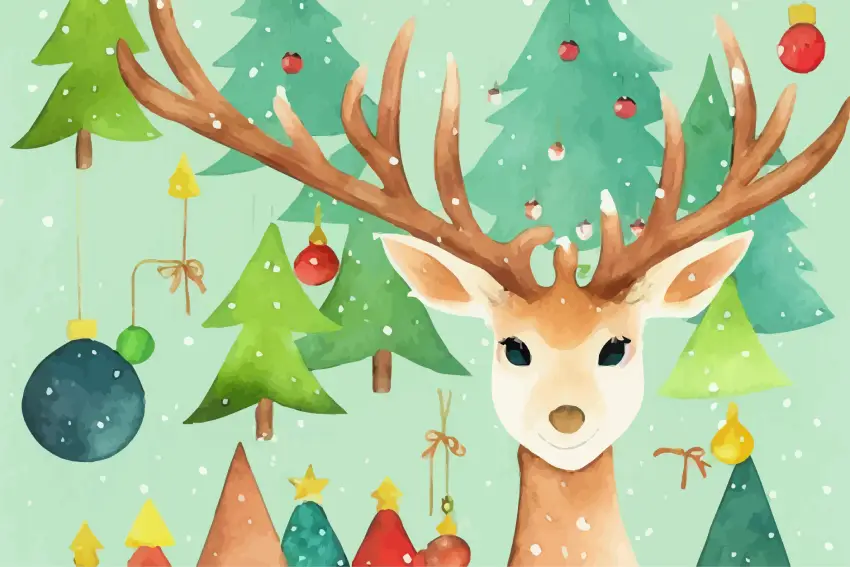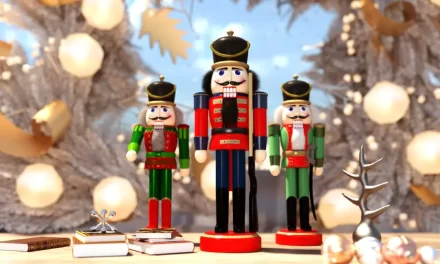Unraveling the Mystique of Rudolph the Red-Nosed Reindeer
As the holiday season approaches, the air becomes infused with the magical spirit of Christmas. Amidst the joyous carols, twinkling lights, and the anticipation of gifts, one iconic figure takes center stage—Santa Claus and his trusty team of reindeer. While the concept of Santa’s reindeer has been a long-standing part of Christmas folklore, there’s one particular reindeer who has captured the hearts of generations: Rudolph the Red-Nosed Reindeer.
In this exploration of the origins of Rudolph and the evolution of reindeers’ association with Santa Claus, we delve into the rich tapestry of Christmas traditions. From ancient myths to contemporary culture, the journey of these festive creatures has been a fascinating one, weaving through literature, song, and popular media. Join us as we unwrap the enchanting story of Rudolph, from his humble beginnings to his enduring legacy, and discover the magic that has made him an integral part of the holiday season.
Get ready to embark on a festive journey that transcends time, exploring the historical roots, the creative minds behind Rudolph, and the cultural impact that has solidified his place in the pantheon of Christmas icons. Rudolph’s story is not merely a tale of a reindeer with a glowing nose but a testament to the enduring power of storytelling and the timeless joy that the holiday season brings.
Historical Connection
Early References in Folklore and Mythology
Long before the red-nosed reindeer guided Santa’s sleigh through snowy skies, these majestic creatures held a special place in folklore and mythology. In various cultures, reindeers were often associated with winter and the mystical elements of the season. The Norse god, Odin, was said to ride through the winter sky on an eight-legged horse, which some believe laid the groundwork for the concept of Santa’s eight reindeer.
As the centuries passed, tales of magical reindeer pulling sleighs laden with gifts became woven into the fabric of winter celebrations, contributing to the global fascination with these resilient Arctic animals.
Transition to Popular Culture
The assimilation of reindeer into popular Christmas culture can be traced back to the 19th century. A pivotal moment occurred with the publication of Clement Clarke Moore’s poem, “A Visit from St. Nicholas,” more commonly known as “The Night Before Christmas.” Moore’s vivid depiction of Santa Claus and his reindeer team—complete with names like Dasher, Dancer, Prancer, Vixen, Comet, Cupid, Donner, and Blitzen—cemented the association between Santa and his loyal reindeer companions.
This fusion of folklore and literature marked a turning point, setting the stage for the evolution of the reindeer’s role in Christmas festivities. The enchanting idea of Santa relying on these swift and graceful creatures captured the imagination of generations, laying the foundation for the emergence of one particularly special reindeer, Rudolph, in the early 20th century.
Clement Clarke Moore’s “A Visit from St. Nicholas”
Introduction of Santa’s Reindeer
Clement Clarke Moore’s iconic poem, “A Visit from St. Nicholas,” first published anonymously in 1823, was a groundbreaking moment in shaping the modern image of Santa Claus and his reindeer. The poem not only popularized the image of Santa as a jolly, rotund figure but also introduced the world to his team of reindeer. These magical creatures, with their whimsical names and swift abilities, added a touch of fantasy to the Christmas narrative, capturing the imaginations of both young and old.
Establishment of the Reindeer Team
Moore’s poem provided a detailed account of Santa’s sleigh and his eight reindeer, painting a vivid picture of the airborne journey on Christmas Eve. The concept of a team of reindeer working in unison to carry Santa and his sleigh became a central element of the Santa Claus mythology. The names assigned to each reindeer not only added character to the story but also contributed to the enduring popularity of the narrative.
This poem served as a cultural touchstone, firmly establishing the connection between Santa Claus and his trusty reindeer team, becoming a cherished tradition passed down through generations. As Christmas traditions continued to evolve, the image of Santa and his reindeer became synonymous with the festive season, setting the stage for the emergence of new characters and stories, including the beloved Rudolph the Red-Nosed Reindeer.
Commercialization and Popularity
Role in Christmas Imagery
As the 19th century gave way to the 20th, the commercialization of Christmas began to take shape. Illustrators and artists seized the opportunity to bring the enchanting scenes from “A Visit from St. Nicholas” to life. Magazines and newspapers featured illustrations of Santa Claus and his reindeer, solidifying their place in the visual lexicon of Christmas.
These illustrations not only fueled the festive imagination but also contributed to the creation of a distinct Christmas aesthetic. Reindeer, with their graceful antlers and gentle demeanor, became symbols of the season’s magic, featured on everything from holiday cards to festive decorations.
Popularization through Art and Literature
The widespread adoption of the imagery of Santa and his reindeer in various forms of art and literature played a pivotal role in embedding their presence in the public consciousness. Books, poems, and advertisements continued to portray Santa’s reindeer as essential companions on his yuletide journey.
As the 20th century progressed, the integration of reindeer into Christmas lore became so ingrained that the narrative expanded beyond literature to include radio broadcasts, films, and even holiday merchandise. The reindeer, once a magical element in festive tales, became inseparable from the joyous celebration of Christmas, paving the way for the emergence of a singular reindeer whose story would captivate the world: Rudolph the Red-Nosed Reindeer.
Rudolph’s Origins
The Creation of Rudolph
Robert L. May’s Contribution
The genesis of Rudolph the Red-Nosed Reindeer can be traced back to the creative mind of Robert L. May, a copywriter for Montgomery Ward, a department store in the 1930s. In 1939, faced with the challenge of creating a promotional storybook to distribute to customers during the holiday season, May crafted the tale of a misfit reindeer with a distinctive feature—a glowing red nose.
The Original Story
May’s original story focused on Rudolph’s struggles with acceptance due to his unique appearance. However, it took a heartwarming turn as Rudolph’s radiant nose proved to be an asset, guiding Santa’s sleigh through a foggy Christmas Eve. The story resonated with readers, and the character of Rudolph quickly captured the imagination of children and adults alike.
Publication and Reception
The Montgomery Ward Connection
Montgomery Ward distributed over 2.4 million copies of May’s Rudolph storybook in 1939, creating widespread awareness of this new addition to the Christmas mythology. The department store’s decision to share this tale as a holiday giveaway inadvertently launched Rudolph into the cultural spotlight.
Initial Reception by the Public
Rudolph’s initial reception was overwhelmingly positive, with readers embracing the tale of triumph over adversity and the celebration of uniqueness. The character’s charm and relatability contributed to his swift rise in popularity, laying the foundation for Rudolph’s enduring presence in Christmas celebrations for years to come.
The creation of Rudolph marked a turning point in the portrayal of Santa’s reindeer, introducing a character with depth and relatability, whose journey would soon become a cherished part of Christmas folklore.
Rudolph’s Rise to Fame
Adaptations and Media
Rudolph’s journey from the pages of a storybook to broader media platforms accelerated with adaptations. In 1949, the character made his animated debut in a short film. However, it was Gene Autry’s recording of “Rudolph the Red-Nosed Reindeer” in 1949 that catapulted the character to new heights, turning the narrative into a timeless and catchy song that further embedded Rudolph in popular culture.
Cultural Impact
Rudolph’s impact extended beyond literature and music. Animated specials, beginning with the beloved 1964 television classic, “Rudolph the Red-Nosed Reindeer,” brought the character to life in a way that resonated with audiences of all ages. The enduring popularity of these adaptations ensured that Rudolph became a central figure in Christmas celebrations, earning a place alongside other holiday icons.
Rudolph’s rise to fame was not merely a product of marketing but a testament to the character’s universal themes and the emotional resonance of his story. The red-nosed reindeer had transitioned from a promotional gimmick to a cherished symbol of the Christmas spirit.
Rudolph’s Enduring Legacy – Continued Popularity
Annual TV Broadcasts
One of the key factors contributing to Rudolph’s enduring legacy is the annual television broadcast of the animated special. Since its debut in 1964, “Rudolph the Red-Nosed Reindeer” has become a holiday tradition for families, captivating new generations with its timeless story and charming characters. The annual airing of the special has solidified Rudolph’s place in the hearts of viewers, creating a sense of nostalgia and anticipation each holiday season.
Presence in Contemporary Culture
Rudolph’s popularity hasn’t waned with time; instead, it has continued to thrive in contemporary culture. The red-nosed reindeer remains a prominent figure in Christmas decorations, merchandise, and promotional campaigns. Whether in the form of ornaments, plush toys, or animated displays, Rudolph continues to be a symbol of the joy and magic associated with the holiday season.
Lessons and Values
The Message of Rudolph’s Story
At its core, Rudolph’s story imparts valuable lessons of acceptance, resilience, and the celebration of uniqueness. The character’s journey from an outcast to a hero resonates with audiences of all ages, reminding us that our differences can be our greatest strengths. Rudolph’s tale encourages empathy and understanding, fostering a sense of compassion that transcends the holiday season.
Symbolism and Meaning
Beyond the festive trappings, Rudolph has come to symbolize the triumph of the underdog and the transformative power of compassion. The red nose, once a source of embarrassment, becomes a beacon of hope and guidance. Rudolph’s story serves as a reminder that the holiday spirit extends beyond the surface-level festivities, encouraging individuals to embrace the qualities that make them unique and to extend kindness to others.
Conclusion
Recap of Rudolph’s Journey
From a creation born out of a promotional endeavor to an enduring symbol of Christmas, Rudolph the Red-Nosed Reindeer has carved a permanent place in holiday lore. His journey from the pages of a storybook to animated screens and festive decorations showcases the timeless appeal of a character whose story resonates with the spirit of the season.
The Everlasting Charm of Rudolph
As we embrace the holiday season each year, Rudolph stands as a testament to the enduring charm and significance of Christmas traditions. His red nose continues to guide us through the fog of routine, reminding us to find joy in our uniqueness and to share that joy with others. In the grand tapestry of holiday tales, Rudolph’s story remains a shining thread, weaving its way into the hearts of those who celebrate the magic of Christmas.






